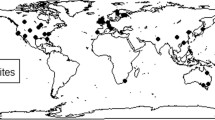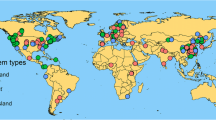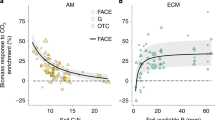Abstract
Magnitude of growth enhancement by elevated CO2 in a plant assemblage is dependent on a number of biotic and abiotic factors, including species richness. In this meta-analysis, we examined effects of elevated CO2 on plant biomass accumulation in single- (populations) and multi-species (communities) assemblages. The primary objectives were to statistically synthesize the voluminous CO2 studies conducted so far and to assess the collective response of plant growth to elevated CO2 as affected by species richness. Our analysis showed that biomass enhancement by higher CO2 was consistently lower in communities than in populations. For example, total plant biomass (W T) increased only 13% in communities compared to 30% in populations in response to elevated CO2 across all studies included in this synthesis. Above- and below-ground biomass responded similarly as W T to elevated CO2 and species richness. Smaller growth enhancement by CO2 was found in communities consisting of species of different growth forms (woody vs. herbaceous species) or functional groups (legumes vs. non-legumes). This pattern was consistent across three major classes of facilities (closed, semi-open and open systems) used to manipulate CO2 concentrations. An analysis of free-air CO2 enrichment studies revealed that the population–community difference in growth enhancement by higher CO2 was also dependent on the rate of N addition. Populations responded more than communities only when soil was amended with N. From the CO2 studies synthesized in this meta-analysis, it is obvious that the collective growth responsiveness to elevated CO2 will be lower in communities than in populations. We hypothesize that resource usurpation, i.e., competitive compartmentation of growth-limiting resources by less responsive species, may be important in determining growth response to elevated CO2 in a community and is one of the reasons responsible for the lower biomass enhancement by elevated CO2 in communities, as found in this synthesis.





Similar content being viewed by others
References
Bazzaz FA, Catovsky S (2002) Plants-from cells to ecosystems: impacts of global environment change. In: Encyclopedia of Global Environment Change. Wiley, Chichester, pp 94–111
Bazzaz FA, Garbutt K (1988) The response of annuals in competitive neighborhoods: effects of elevated CO2. Ecology 69:937–946
Bazzaz FA, McConnaughay KDM (1992) Plant–plant interactions in elevated CO2 environments. Aust J Bot 40:547–563
Curtis PS, Wang XZ (1998) A meta-analysis of elevated CO2 effects on woody plant growth, form, and physiology. Oecologia 113:299–313
Diaz S, Grime JP, Harris J, McPherson E (1993) Evidence of a feedback mechanism limiting plant response to elevated carbon dioxide. Nature 364:616–617
Dukes JS, Chiariello NR, Cleland EE, Moore LA, Shaw MR, Thayer S, Tobeck T, Mooney HA, Field CB (2005) Responses of grassland production to single and multiple global environmental changes. PLoS Biol 3:1829–1837
Eamus D, Jarvis PG (1989) The direct effects of increase in the global atmospheric CO2 concentration on natural and commercial temperate trees and forests. In: Begon M, Fitter AH, Ford ED, Macfadyen A (eds) Advances in ecological research, vol 19. Academic Press, New York, pp 1–55
Field CB, Chapin FS III, Matson PA, Mooney HA (1992) Responses of terrestrial ecosystems to the changing atmosphere. Annu Rev Ecol Syst 23:201–235
Gurevitch J, Hedges LV (1993) Meta-analysis: combining the results of independent experiments. In: Scheiner SM, Gurevitch J (eds) Design and analysis of ecological experiments. Chapman and Hall, New York, London, pp 378–425
Hebeisen T, Luscher A, Nosberger J (1997) Effects of elevated atmospheric CO2 and nitrogen fertilization on yield of Trifolium repens and Lolium perenne. Acta Oecol 18:277–284
Hedges LV, Gurevitch J, Curtis PS (1999) The meta-analysis of response ratios in experimental ecology. Ecology 80:1150–1156
Houghton J, Ding Y, Griggs D, Noguer M, van der Linden P, Dai X, Maskell K, Johnson C (2001) Climate Change 2001. Cambridge University Press, London
Hunt R, Hand DW, Hannah MA, Neal AM (1991) Responses to CO2 enrichment in 27 herbaceous species. Funct Ecol 5:410–421
Huston MA (1997) Hidden treatments in ecological experiments: re-evaluating the ecosystem function of biodiversity. Oecologia 110:449–460
Idso KE, Idso SB (1994) Plant responses to atmospheric CO2 enrichment in the face of environmental constraints: a review of the past 10 years research. Agric For Meteorol 69:153–203
Jennions MD, Moller AP (2002) Publication bias in ecology and evolution: an empirical assessment using the “trim and fill” method. Biol Rev 77:211–222
Kimball BA (1983) Carbon dioxide and agricultural yield: an assemblage and analysis of 430 prior observations. Agron J 75:779–788
Korner C (1995) Towards a better experimental basis for upscaling plant responses to elevated CO2 and climate warming. Plant Cell Environ 18:1101–1110
Korner C (2000) Biosphere responses to CO2 enrichment. Ecol Appl 10:1590–1619
Korner C (2003a) Nutrients and sink activity drive plant CO2 responses—a note of caution with literature based analysis. New Phytol 159:537–538
Korner CH (2003b) Ecological impacts of atmospheric CO2 enrichment on terrestrial ecosystems. Phil Trans R Soc Lond A 361:2023–2041
Kotiaho JS, Tomkins JL (2002) Meta-analysis, can it fail? Oikos 96:551–553
Leadley PW, Stocklin J (1996) Effects of elevated CO2 on model calcareous grasslands: community, species, and genotype level responses. Global Change Biol 2:389–397
Loehle C (1995) Anomalous responses of plants to CO2 enrichment. Oikos 73:181–187
Luo Y, Su B, Currie WS, Dukes JS, Finzi A, Hartwig UA, Hungate B, McMurtrie RE, Oren R, Parton WJ, Pataki D, Shaw MR, Zak D, Field CB (2004) Progressive nitrogen limitation of ecosystem responses to rising atmospheric carbon dioxide. BioScience 54:731–739
Luscher A, Hendrey GR, Nosberger J (1998) Long-term responsiveness to free air CO2 enrichment of functional types, species and genotypes of plants from fertile permanent grassland. Oecologia 113:37–45
McCarthy HR, Oren R, Finzi AC, Johnsen KH (2006) Canopy leaf area constrains [CO2]-induced enhancement of productivity and partitioning among aboveground carbon pools. Proc Natl Acad Sci USA 103:19356–19361
Melillo JM, Mcguire AD, Kicklighter DW, Moore B III, Vorosmarty CJ, Schloss AL (1993) Global climate change and terrestrial net primary production. Nature 363:234–240
Moller AP, Jennions MD (2001) Testing and adjusting for publication bias. Trends Ecol Evol 16:580–586
Navas ML (1998) Individual species performance and response of multi-specific communities to elevated CO2: a review. Funct Ecol 12:721–727
Navas ML, Garnier E, Austin MP, Gifford RM (1999) Effect of competition on the responses of grasses and legumes to elevated atmospheric CO2 along a nitrogen gradient: differences between isolated plants, monoculture and multi-species mixtures. New Phytol 143:323–331
Niklaus PA, Leadley PW, Stocklin J, Korner C (1998) Nutrient relations in calcareous grassland under elevated CO2. Oecologia 116:67–75
Norby RJ, DeLucia EH, Gielen B, Calfapietra C, Giardina CP, King JS, Ledford J, McCarthy HR, Moore DJP, Ceulemans R, De Angelis P, Finzi AC, Karnosky DF, Kubiske ME, Lukac M, Pregitzer KS, Scarascia-Mugnozza GE, Schlesinger WH, Oren R (2005) Forest response to elevated CO2 is conserved across a broad range of productivity. Proc Natl Acad Sci USA 102:18052–18056
Norby RJ, Wullschleger SD, Gunderson CA, Johnson DW, Ceulemans R (1999) Tree responses to rising CO2 in field experiment: implications for the future forest. Plant Cell Environ 22:683–714
Nowak RS, Ellsworth DS, Smith SD (2004) Functional responses of plants to elevated atmospheric CO2—do photosynthetic and productivity data from FACE experiments support early predictions? New Phytol 162:253–280
Oren R, Ellsworth DS, Johnsen KH, Phillips N, Ewers BE, Maier CA, Schafer KVR, McCarthy H, Hendrey G, McNulty SG, Katul GG (2001) Soil fertility limits carbon sequestration by forest ecosystems in a CO2-enriched atmosphere. Nature 411:469-472
Owensby CE, Coyne PI, Ham JM, Auen LM, Knapp AK (1993) Biomass production in a tallgrass prairie ecosystem exposed to ambient and elevated CO2. Ecol Appl 3:644–653
Palmroth S, Oren R, McCarthy H, Johnsen KH, Finzi A, Butnor JR, Ryan MG, Schlesinger WH (2006) Aboveground sink strength in forests controls the allocation of carbon below ground and its [CO2]-induced enhancement. Proc Natl Acad Sci USA 103:19362–19367
Petit JR, Jouzel J, Raynaud D, Barkov NI, Barnola JM, Basile I, Bender M, Chappellaz J, Davis M, Delaygue G, Delmotte M, Kotlyakov VM, Legrand M, Lipenkov VY, Lorius C, Pepin L, Ritz C, Saltzman E, Stievenard M (1999) Climate and atmospheric history of the past 420,000 years from the Vostok ice core, Antarctica. Nature 399:429–436
Poorter H (1993) Interspecific variation in the growth response of plants to an elevated ambient CO2 concentration. Vegetatio 104/105:77–97
Poorter H, Navas ML (2003) Plant growth and competition at elevated CO2: on winners, losers and functional groups. New Phytol 157:175–198
Poorter H, Perez-Soba M (2001) The growth response of plants to elevated CO2 under non-optimal environmental conditions. Oecologia 129:1–20
Rastetter EB, Agren GI, Shaver GR (1997) Responses of N-limited ecosystems to increased CO2: a balanced-nutrition, coupled-element-cycles model. Ecol Appl 7:444–460
Reich P, Hobbie SE, Lee T, Ellsworth DS, West JB, Tilman D, Knops JM, Naeem S, Frost J (2006) Nitrogen limitation constrains sustainability of ecosystem response to CO2. Nature 440:922–925
Reich PB, Knops J, Tilman D, Craine J, Ellsworth D, Tjoelker MG, Lee T, Wedin D, Naeem S, Bahauddin D, Hendrey G, Jose S, Wrage K, Goth J, Bengston WW (2001a) Plant diversity enhances ecosystem responses to elevated CO2 and nitrogen deposition. Nature 410:809–812
Reich PB, Tilman D, Craine J, Ellsworth D, Tjoelker MG, Knops J, Wedin D, Naeem S, Bahauddin D, Goth J, Bengtson W, Lee TD (2001b) Do species and functional groups differ in acquisition and use of C, N and water under varying atmospheric CO2 and N availability regimes? A field test with 16 grassland species. New Phytol 150:435–448
Reich PB, Tilman D, Naeem S, Ellsworth DS, Knops J, Craine J, Wedin D, Trost J (2004) Species and functional group diversity independently influence biomass accumulation and its response to CO2 and N. Proc Natl Acad Sci USA 101:10101–10106
Reynolds HL (1996) Effects of elevated CO2 on plants grown in competition. In: Korner C, Bazzaz FA (eds) Carbon dioxide, populations, and communities. Academic, San Diego, pp 273–286
Rosenberg NJ, Adams DC, Gurevitch J (2000) MetaWin: statistical software for meta-analysis. In: MetaWin: statistical software for meta-analysis. Version 2.0. edn. Sinauer Associates, Sunderland, Mass.
Song FJ, Eastwood AJ, Gilbody S, Duley L, Sutton AJ (2000) Publication and related biases. Health Technol Assess 4:1–115
Teughels H, Nijs I, Van Hecke P, Impens I (1995) Competition in a global change environment: the importance of different plant traits for competitive success. J Biogeogr 22:297–305
Tomkins JL, Kotiaho JS (2004) Publication bias in meta-analysis: seeing the wood for the trees. Oikos 104:194–196
van Ruijven J, Berendse F (2005) Diversity-productivity relationships: initial effects, long-term patterns, and underlying mechanisms. Proc Natl Acad Sci USA 102:695–700
Weiner J (1985) Size hierarchies in experimental populations of annual plants. Ecology 66:743–752
Woodward FI (1992) Predicting plant responses to global environmental change. New Phytol 122:239–251
Wullschleger SD, Norby RJ, Gunderson CA (1997) Forest trees and their response to atmospheric carbon dioxide enrichment: a compilation of results. In: Allen LH, Kirkham MB, Olszyk DM, Whitman CE (eds) Advances in carbon dioxide effects research. American Society of Agronomy, Madison, Wis., pp 79–100
Zanetti S, Hartwig UA, Van Kessel C, Luscher A, Hebeisen T, Frehner M, Fischer BU, Hendrey GR, Blum H, Nosberger J (1997) Does nitrogen nutrition restrict the CO2 response of fertile grassland lacking legumes? Oecologia 112:17–25
Acknowledgements
Thanks are due to all the anonymous referees for thorough and critical reviewing of an earlier version of this manuscript. Financial support for this project was provided in part by the School of Science, Indiana University–Purdue University Indianapolis (IUPUI) and the IUPUI Office of Professional Development. We thank the Interlibrary Loan Team at the IUPUI University Library for obtaining a large number of articles for this project. The technical support of Isaac Arthur, Alex Owusu-Agyeman, Ryan Jenkinson, Doug Latino, Ly Khan Vu and a number of other students is gratefully acknowledged. This synthesis complies with the current laws of the United States, in which the analysis was conducted.
Author information
Authors and Affiliations
Corresponding author
Additional information
Communicated by Ram Oren.
Electronic supplementary material
Below is the link to the electronic supplementary material.
Rights and permissions
About this article
Cite this article
Wang, X. Effects of species richness and elevated carbon dioxide on biomass accumulation: a synthesis using meta-analysis. Oecologia 152, 595–605 (2007). https://doi.org/10.1007/s00442-007-0691-5
Received:
Accepted:
Published:
Issue Date:
DOI: https://doi.org/10.1007/s00442-007-0691-5




